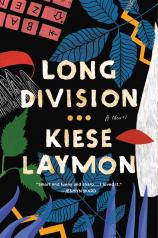Long Division
Review
Long Division
Kiese Laymon, author of the critically acclaimed memoir HEAVY, has written LONG DIVISION, a work of fiction that combines themes of viral celebrity, storytelling, racism and religion for a coming-of-age, time-traveling tale rich in satire and sharp observations.
Citoyen “City” Coldson is a “White Homeless Fat Homosexual.” At least that’s what his high school rival, LaVander Peeler, will tell you. In truth, he’s a chubby 14-year-old Black boy who is definitely interested in girls (just ask him how many times he’s “gotten nice” with himself thinking about the girls he grew up with), but he’s also just maybe a little obsessed with LaVander. As the best boy writer and best boy reader, respectively, at Fannie Lou Hamer Magnet School, City and LaVander find themselves thrown together way more than they’d like, most recently because of the "Can You Use That Word in a Sentence" contest, an un-geographically biased version of the Scripps National Spelling Bee that’s more accessible for teens in the Deep South, Midwest and Southwest. And this year, they are dead set on bringing the trophy home to Mississippi by showing the judges that they can use any given word in a sentence correctly, appropriately and dynamically --- whatever that means.
"Full of some of the most stunning descriptions I have ever read and plenty of head-scratching moments of surrealism, LONG DIVISION is a bewildering gem of a novel."
Tensions are rising as City and LaVander prepare for the contest --- a nationally televised event --- and as they bounce wordy sentences at and off one another, it becomes clear that while LaVander might act more refined and City might play the class clown, both boys are angry at the state of post-Katrina Mississippi in 2013 and the country’s treatment of its Black citizens. Their anger is fueled even more when they learn that not only are the producers trying to present them as stereotypical Black teens (complete with wave combs and Rocawear shirts), the contest appears to be rigged. Their competitors are white twins from Louisiana and two Mexican siblings from Arizona, and LaVander overhears the producers discuss which one of the two token Black boys will win, and which Mexican sibling he will beat to take the lead.
After witnessing LaVander bow down to the racist words he is given, City is asked to use “niggardly” in a sentence, and all hell breaks loose. City eviscerates the judges --- and, unfortunately, his fellow contestants --- in some of the most vitriolic wordplay ever seen and walks off the stage a legend.
Shortly before this epic meltdown, City’s principal gave him the gift of an unauthored book, Long Division, explaining that it might help him respect his Black ancestors who fought for his freedoms. It is this book that he focuses on when his mother sends him to the small community of Melahatchie to stay with his grandmother as punishment. But having never seen boys like him and towns like his in a book, City is even more shocked to see that despite being set in 1985, the main character is Black like him, stout like him, and has the same first name as him. The protagonist even uses terms like “chunky vomit” like him. Even stranger, there’s a secondary character named Baize Shephard, which also happens to be the name of a teenage girl who disappeared from Melahatchie recently, igniting viral news coverage and desperate pleas for her safe return. Something funky is happening in Long Division and in Melahatchie --- and with no LaVander to sling sentences at, City dedicates himself to finding out what is going on.
As strange parallels between his life and the plot of Long Division keep presenting themselves and his viral celebrity takes off, City finds himself thrust between the divisions of story and storyteller, religion and violence, culture and acceptance. In the novel’s second half, Laymon takes us inside Long Division itself, where we meet City in 1985, his love interest Shalaya Crump, and Baize, the time-traveling orphan rapper. Present-day City will need these counterparts, LaVander's sentence-slinging wisdom and the support of his community to solve the mystery of Baize’s disappearance and figure out what it means for him to take ownership of his identity and culture amid brutal entanglements with race, Jim Crow laws and discrimination in America --- past and present.
Full of some of the most stunning descriptions I have ever read and plenty of head-scratching moments of surrealism, LONG DIVISION is a bewildering gem of a novel. As in HEAVY, Laymon’s control of the written word is unparalleled, his descriptions vivid and raw. When City’s Uncle Relle opens his mouth, “it sounded like big old flat tires rolling over jagged gravel,” and when LaVander cries, “still water flood[s] the gutters of [his] eyes” --- and that’s only the beginning of Laymon’s most beautiful phrases. A wordsmith himself, the character of City is cocky, intelligent, and stuck between the identity placed upon him by his “post-racial” country and the identity he is desperate to carve out for himself. His coming of age combines all the best parts of Mark Twain with the searing timeliness of Nic Stone and Nancy Johnson for something uniquely Laymon, as vulnerable and steadfast as the man we met in HEAVY. Baize, too, is a highlight of the book, and her story arc is as satisfying as it is gripping.
You’ll have to suspend your disbelief a bit --- okay, a lot --- for some of the time-travel science, but if you can latch onto City’s voice and Baize’s wisdom, you’re sure to learn something from this profound, darkly funny book.
Reviewed by Rebecca Munro on June 11, 2021
Long Division
- Publication Date: June 1, 2021
- Genres: Fiction
- Paperback: 304 pages
- Publisher: Scribner
- ISBN-10: 198217482X
- ISBN-13: 9781982174828




